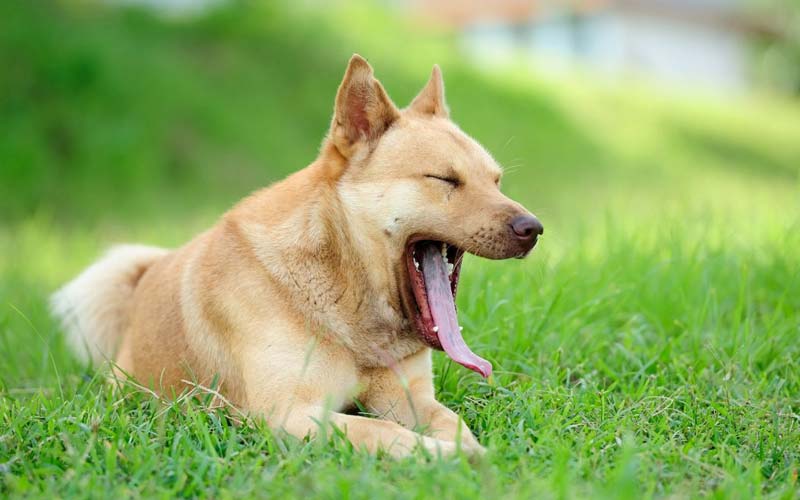Have you ever noticed your dog yawning and wondered if it means more than just being tired? While yawning in humans is often a response to fatigue or boredom, in dogs, it can signify a wide range of emotions and physical states. From expressing stress or excitement to signaling comfort or even mimicking your own yawns, a dogs yawn is a nuanced form of communication.

Understanding why your dog yawns is key to decoding their behavior and strengthening the bond between you. By paying attention to the context and accompanying body language, you can gain valuable insights into their emotional and physical well-being.
In this article, well explore the fascinating reasons behind dog yawning, from their role as calming signals to possible health concerns. Whether youre a seasoned pet owner or new to the world of dogs, this guide will help you interpret your canine companions yawns like a pro.
1. The Basics of Dog Yawning
What is Yawning?
Yawning in dogs is a natural reflex characterized by a wide opening of the mouth followed by a deep inhalation and a slow exhalation. While yawning is commonly associated with tiredness or relaxation in both humans and dogs, it can also serve other purposes for our canine companions.
Unlike humans, who typically yawn as a response to physical fatigue or boredom, dogs use yawning as a multi-functional behavior. For them, it can indicate emotional states, such as stress or excitement, and even act as a form of communication. Dogs are highly attuned to their environment, and their yawns often occur in response to specific triggers, ranging from calming social cues to moments of anticipation.
Common Reasons for Dog Yawning:
- Tiredness or Relaxation: Similar to humans, dogs yawn as a way to release tension or signal that theyre ready to rest. Emotional Expression: Beyond fatigue, yawning might indicate excitement, nervousness, or an attempt to calm themselves in a stressful situation.
Is Yawning Contagious?
Interestingly, yawning can be contagious in dogs, just as it is in humans. Studies suggest that dogs may yawn in response to seeing their owners or other dogs yawn, a behavior that highlights their empathetic nature. This phenomenon, often referred to as canine empathy, reflects the bond dogs share with their humans and their ability to pick up on emotional cues.
Dogs are social animals, and contagious yawning might also serve as a way to strengthen pack dynamics. By mimicking another dogs or humans yawn, dogs may be reinforcing a sense of connection and understanding.
Researchers have found that dogs are more likely to yawn contagiously when they share a close relationship with the yawner, further supporting the idea that yawning is linked to empathy and social bonding. So, the next time you yawn and catch your dog yawning back, it might just be their way of saying, “I’m with you!”
This foundational understanding of yawning lays the groundwork for exploring its deeper emotional and communicative significance in dogs.

2. Emotional Signals Behind Yawning
Stress and Anxiety
Yawning in dogs is often linked to their emotional state, serving as a subtle signal of stress or anxiety. Unlike a tired yawn, stress yawns tend to occur in situations where a dog feels overwhelmed, uncertain, or uncomfortable.
For example, a dog might yawn during a visit to the veterinarian, in a crowded park, or when surrounded by loud noises. This behavior functions as a calming signal, a way for the dog to self-soothe and communicate its unease to others.
Tips for Addressing a Stressed Dog:
- Create a Calming Environment: Provide a quiet, familiar space for your dog to relax.
- Identify Triggers: Observe patterns to identify what’s causing your dog’s stress, whether it’s a specific place, sound, or situation.
- Offer Reassurance: Speak calmly and use comforting gestures to help your dog feel secure.
By recognizing yawning as a stress indicator, pet owners can intervene early, creating a sense of safety and reducing anxiety.
Excitement and Anticipation
Dogs also yawn when they’re excited, such as before a walk, during playtime, or when their favorite human comes home. Unlike stress yawns, these yawns are part of an energetic emotional response, often accompanied by wagging tails or playful behavior.
However, excessive excitement can lead to difficulty in focus or self-regulation. If a dog frequently yawns in anticipation, it might benefit from structured activities to channel its energy.
Tips for Managing Excessive Excitement:
- Use commands like “sit” or “stay” to encourage calm behavior before engaging in exciting activities.
- Incorporate regular physical and mental exercises to balance energy levels.
- Submission and Social Cues
Yawning can also act as a non-threatening social signal, especially in interactions with other dogs. In group settings, a dog might yawn to display submission or to diffuse tension, signaling that it doesn’t pose a threat.
For example, a yawn during a face-to-face encounter with another dog might help defuse a potentially stressful interaction. This behavior is part of a dog’s innate ability to navigate social dynamics effectively.
Recognizing these yawning patterns not only deepens our understanding of canine behavior but also enhances our ability to respond appropriately to their emotional needs. By decoding these subtle signals, owners can foster trust and strengthen their bond with their dogs.

3: Physical and Health Considerations
Fatigue and Relaxation
Yawning is most commonly associated with tiredness or a state of winding down, much like in humans. When your dog stretches their mouth wide in a slow, exaggerated motion, it’s often a sign they’re ready for a nap or transitioning into a more relaxed state.
This type of yawn typically occurs during predictable moments, such as after a long day of activity, during quiet evenings, or when your dog is getting ready for bed. Recognizing this behavior as part of your dog’s natural routine can help you understand when they need rest and downtime to recharge.
Pain or Discomfort
In some cases, excessive yawning can signal an underlying health concern. When yawning occurs frequently and outside of contexts like fatigue or stress, it could indicate pain, discomfort, or even a medical issue.
Possible Causes of Excessive Yawning:
- Dental Pain: Issues such as gum disease, a broken tooth, or oral injuries may lead to frequent yawning as a coping mechanism for discomfort.
- Respiratory Distress: Conditions like brachycephalic airway syndrome (common in flat-faced breeds) or infections affecting breathing may prompt repetitive yawning.
- Neurological Concerns: While rare, excessive yawning can sometimes be linked to neurological disorders or abnormalities affecting the brain.
When to Consult a Veterinarian:
- Yawning becomes unusually frequent or intense.
- It occurs alongside other symptoms, such as drooling, coughing, lethargy, or changes in behavior.
- Your dog exhibits signs of pain, like whining, restlessness, or a lack of appetite.
Prompt veterinary attention ensures that any health issues are identified and addressed early, preventing unnecessary discomfort for your pet.
By understanding the physical and health-related reasons for yawning, dog owners can better distinguish between normal behaviors and signs of potential concern, ensuring their furry friends remain happy and healthy.

4. How to Interpret Yawning in Context
A. Observe the Situation
To understand why your dog is yawning, context is key. Pay attention to when and where the yawning happens, as this can offer valuable clues about its meaning. For instance, if your dog yawns during a loud gathering or while being approached by an unfamiliar dog, it might be a sign of stress. On the other hand, a yawn during a lazy afternoon on the couch likely indicates relaxation.
By observing the surrounding circumstances, you can differentiate between a stress yawn, a fatigue yawn, or one driven by excitement or social cues.
B. Body Language Clues
Yawning rarely occurs in isolation. Dogs use their entire bodies to communicate, and pairing yawning with other behaviors can provide a more complete picture of their emotional state.
Common Companion Behaviors:
- Licking Lips: Often a sign of nervousness or submission.
- Pacing: Indicates restlessness or anxiety.
- Avoiding Eye Contact: A calming signal, often meant to reduce tension.
- Tail Position: A tucked tail might accompany stress yawns, while a wagging tail might signify excitement.
By recognizing these additional signals, you can better interpret your dog’s yawning and respond appropriately.
C. Examples: Real-World Scenarios
Scenario 1: At the Vet’s Office
Your dog yawns repeatedly while sitting in the waiting room. They also avoid looking at other pets and sit with a tense posture. This combination of signals suggests your dog is feeling stressed. Offering reassurance or bringing a favorite toy might help ease their anxiety.
Scenario 2: Before a Walk
Your dog yawns as you pick up their leash and put on your shoes. Their body language is loose, and their tail wags enthusiastically. In this case, the yawn reflects anticipation and excitement. Using commands like “sit” before heading out can help channel their energy constructively.
Scenario 3: Meeting a New Dog
During an introduction to another dog, your dog yawns and turns their head away while keeping a neutral posture. This likely indicates a non-threatening gesture, signaling to the other dog that they don’t want to engage in conflict. Allowing the interaction to unfold naturally without forcing engagement is the best approach.
By carefully observing the context and combining yawning with other body language cues, dog owners can gain deeper insights into their pet’s emotions and intentions. This awareness fosters better communication and a stronger bond between dogs and their humans.

5. What to Do if You’re Concerned
If you’re noticing frequent yawning in your dog and are unsure if it’s a sign of something more serious, there are several steps you can take to address your concerns.
Monitor Behavior
One of the best ways to identify potential issues is by keeping track of your dog’s yawning habits. Consider maintaining a journal where you record the time of day, the frequency, and any other behaviors that accompany the yawns (like restlessness, changes in posture, or anxiety). Tracking these patterns can help determine if the yawning is associated with specific triggers such as certain activities, environments, or interactions. For example, if your dog yawns more frequently when around certain people or in stressful situations, this could indicate anxiety. Documenting these moments gives you a clearer picture of your dog’s health and emotional state.
Consult a Professional
If you’re still unsure or if you notice other concerning symptoms—such as lethargy, loss of appetite, or excessive drooling—it may be time to consult a professional. A veterinarian can help rule out any underlying medical conditions such as pain, discomfort, or neurological issues that might be contributing to your dog’s yawning. If the yawning seems related to behavioral concerns, a professional dog trainer or behaviorist may offer strategies to reduce anxiety or stress and teach your dog more appropriate ways of communicating. Seeking expert advice ensures that your dog receives the proper care and support they need.
Provide Comfort
Supporting your dog’s emotional and physical well-being is key when managing any unusual behavior. If your dog seems to be yawning due to stress or anxiety, create a calm, safe space for them in your home where they can retreat and relax. Engaging in calming activities, such as gentle petting, interactive toys, or low-energy walks, can help alleviate tension and offer reassurance. Additionally, providing a comfortable environment with cozy bedding and minimal noise can help reduce external stressors. Being attentive to your dog’s emotional needs not only supports their health but can also help them feel more secure and less prone to anxious behaviors like excessive yawning.

Conclusion
In summary, while yawning is a common and natural behavior in dogs, understanding the context behind it can help you better support your dog’s health and emotional well-being. Whether it’s a sign of relaxation, anxiety, or something more serious, paying attention to your dog’s yawning patterns, monitoring accompanying behaviors, and consulting a professional when needed are essential steps in ensuring their happiness and health. If you notice unusual frequency or context, don’t hesitate to seek advice from a veterinarian or a trained professional to rule out any underlying issues.
By staying observant, providing comfort, and offering consistent care, you can help your dog lead a balanced and stress-free life. So, start by keeping track of their yawning habits and creating a nurturing environment. Your attention and proactive approach will make a world of difference in your dog’s well-being.